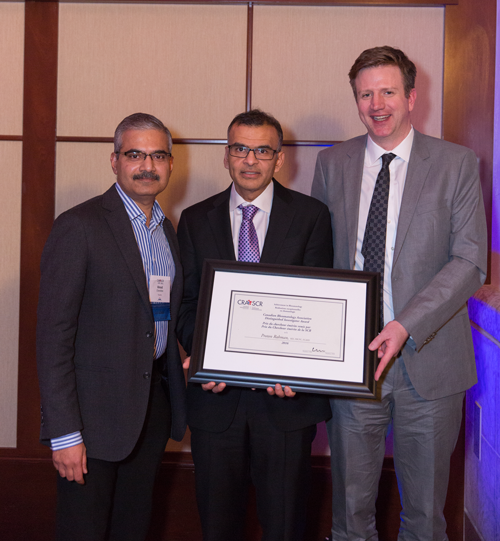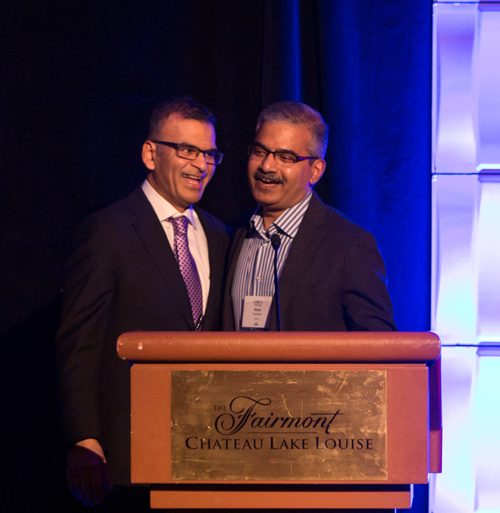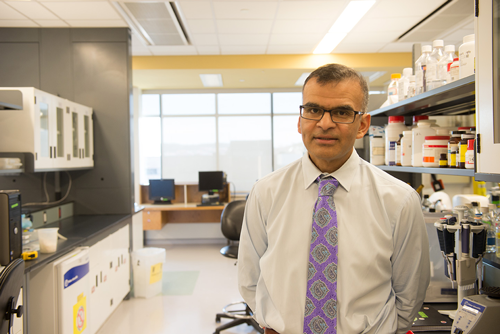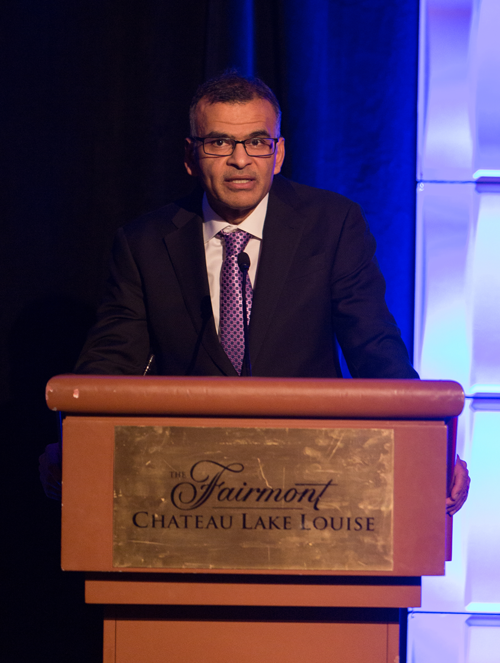Summer 2016 (Volume 26, Number 2)
Distinguished Investigator:
Dr. Proton Rahman
Download PDF

Our sources tell us Proton is not, in fact, your given name. What is the origin of your moniker?
As things have turned out, my nickname has clearly been my most distinguishing feature. The origin of “Proton” is still not absolutely clear to me, as I have heard different versions from my parents. What is clear, however, is that my mom has been calling me this since I was an infant. I was born in Toronto, a year after my parents came to Canada from Bangladesh. My mother knew very little English when I was born. Apparently, Mom liked the way the word sounded when Dad, an electrical engineer, was reading out loud one day. Dad was amused by this, so Mom persisted to call me Proton. (For the record, my sister’s name is Diana and brother’s name is Adam).
You have spent the past several years studying the epigenetics of spondyloarthritis and the identification of genes using next generation sequencing approaches. What are some of the major breakthroughs you have had with your research?
Honestly, I am not totally comfortable with the word “breakthrough” when it comes to my work. What I have done is to systematically evaluate some emerging genomic technologies in rheumatic diseases. With this, I have been able to contribute to a better understanding of how common and rare genetic variants and post-translational modifications (i.e., epigenetic changes) can potentially impact our diseases. These are evolving concepts and the true significance and impact will become clear over the next few years.
What was your first thought when you learned that you would receive this award?
I was rushing to get to a meeting on a busy street when I was first told that I was receiving this award. I politely said “thank you” and carried on. It took a few seconds for the weight of what had just happened to sink in, but then I broke out in a huge grin. Once I got to the lecture theatre, I began to reflect on the situation. I was—and still am—very honoured and humbled to receive this award. I am fully aware of the calibre of outstanding researchers that exist in Canada, and the accomplishments of previous winners. At some point in my career, being considered among the top investigators would have been very satisfying. Actually, winning this award surpassed my expectations. 
No further investigation needed: Dr. Proton Rahman received his award from
Dr. Vinod Chandran and Dr. Cory Baillie.
In 2002 you were the CRA Young Investigator. At the time, you noted some trepidation about “expectations that better things are yet to come.” Where do you stand on that statement now? What changes have the intervening years brought, and what changes remain on the horizon?
The start of any research can be very intimidating. I was fortunate to receive the CRA Young Investigator Award after three years of being an independent investigator. Although the potential for a successful career may have been there, there was also a fair amount of uncertainty about how things would progress. The largest stress in being an investigator is carving out a path that will allow you to sustain your research funding. This is particularly the case for genetic research, where carrying out studies is inherently expensive given the cost of collecting families, purchasing chips, and buying high throughput genomic platforms. I was very fortunate to get timely salary and operating support from The Arthritis Society and the Canadian Institutes of Health Research (CIHR) to establish my program and also develop strategic
partnerships. This allowed me the opportunity to accomplish my initial goals and get my foot in the door as an established investigator. Even though funding continues to be my greatest challenge, having been engaged in active research for over 15 years now serves as reassurance and provides a calming influence. I am now much more confident about what I have to contribute and how best to go about doing this.
How does your research influence the clinical care of patients? What are you able to translate from the research lab to the examining room?
A very unique feature of our lab is the creation of a translational laboratory. This may be a first in Canada, where our clinical lab, Eastern Health, and our research lab share common platforms and resources. Thus, the results from our research lab are done to such a standard that they can be rolled out clinically.
Now with the advent of exome sequencing we are routinely identifying rare, private mutations in our families with autoimmune disease that have been important for diagnosis, determining prognosis, and in implementing treatment strategies. This has been very gratifying. I have also been involved in developing a new screening test
for axial spondyloarthritis, which I hope will surpass
traditional B27-allele testing in terms of cost and specificity.
Are there other areas of interest you would like to investigate in the future? What projects will you be undertaking this year?
This is an exciting time for my laboratory, as we have now established a state of the art genomics facility with multiple “omic” technologies, an IBM-based high-performance computational infrastructure, and strong bio-informatics support. This has allowed us an interomic approach including interrogation of genomics, transciptomics, and epigenomics. I am also attempting to embark on linking these data to de-identified patient datasets.
Our present emphasis is to prepare our rheumatology community for the paradigm shift that will undoubtedly occur as a result of precision medicine and precision public health. I am hoping to help redefine autoimmune rheumatic disease with the incorporation of genomic variants along with clinical and serological features. Using genomic technologies for early identification, disease prognostication, and to better target therapeutics based on patients’ genetic profiles is of great importance. I also want to help target specific populations at risk for developing autoimmune disease and attempt to prevent or alter the natural history of the disease by changing the potential environmental trigger.

A jovial moment at the CRA ASM Gala Dinner.
If you could choose an age to remain forever, which age would you choose?
I would freeze things now. I feel that this is the happiest I can ever be. I am blessed to have an incredible wife and kids that are still at home. Both sets of parents, mine and my wife’s, live in the same town and all are healthy in their 70s. My siblings are well and very successful. Finally, I have a sense of pride about my work and financial security. Too bad things have to change.
You are the 5th person to win both the CRA Young Investigator and Distinguished Investigator awards. What commonalities do you see among successful researchers?
Firstly: A love of science! That being said, scientific curiosity is not enough. You need a fire in your belly and a willingness to make quite a sacrifice. Research clearly invades your home life and clinical duties. As such, you need a very supportive family and enthusiastic colleagues who will support your endeavours—I am fortunate to have both.
There is an additional point, which is obviously an opinion: Prior success also leads to future success. In today’s funding environment, a pedigree of sustained funding and productivity is essential. Independent research requires funding, and this is the hardest challenge to overcome when maintaining a longstanding research program. Because of this, unfortunately, I think you are less likely to see mid-career clinician scientists emerging. Thus I fully anticipate that the trend of Young Investigators being nominated as Distinguished Investigators (especially given the track record of the Young Investigators nowadays) will continue.
Your work in establishing the Newfoundland Genealogy Database has shaped the landscape of health research. What role does Newfoundland have to play in your success? Could you have envisioned carrying out this research elsewhere in Canada?
The Newfoundland founder population has played an important role in my success. I purposefully have spent time and resources to better characterize the genetic architecture of our population and the potential
advantages it poses for genetic studies in rheumatic
disease as well as other complex diseases. This has allowed us to strategically collect informative samples, which have contributed to the identification of genetic variants in multiple autoimmune rheumatic diseases. I am also determined to grow Newfoundland’s reputation for innovation and make significant contributions to the province’s
success with respect to R&D and economic performance.
While our research could be carried out elsewhere, the emphasis on the founder population would not be there. If I were to be in a major urban center, the emphasis would be on a large sample collection and studying the impact of ethnic diversity on the genetic association. Either way, I think understanding population architecture is very important.

Dr. Rahman in his Memorial University lab. Photo credit: Jennifer Armstrong.
What do you believe are the qualities of a Distinguished Investigator? Moreover, how do they apply to you?
Qualities include scientific curiosity, determination, adaptability, and management skills. You need to have a good understanding of medicine in general, and in-depth knowledge of your scientific area. As new information is always emerging, it is essential to carefully evaluate these studies. Having good background knowledge is not necessarily enough. In order to generate new data, the next step is to challenge existing theories or perceptions.
You need to be patient with your staff and students, as a lot of the actual work will be left to them. Mistakes will happen, but you must instill trust in them so you are told of any mistake in order to make sure that the data integrity is not compromised. You then need to adapt to these mistakes without losing your focus. Finally, you need to have great management, business, and communication skills. In many ways, when you employ 20 to 30 staff/students you are, in essence, running a business. You need to have a clear vision, interact well with people, be fair and accommodating, and communicate your message clearly and consistently, all while not being intimidated. I am not sure if I have all these desired attributes, but I have learned to accommodate for what is missing by being transparent and always working hard.
You have served as mentor to some up-and-coming names in Canadian rheumatology. What role have mentors played in shaping your career trajectory and your research interests?
Mentors continue to play a significant role in
my career. Dr. David Murray, a nephrologist at Memorial University, championed my potential, so I had a very positive experience in medical school and residency. Dr. Dafna Gladman introduced me
to research, facilitated my funding (including a short period of time when I had no funding as a
fellow, and it magically appeared from her) and taught me patience, scientific rigour, and the importance of completing a body of work, irrespective of whether it will lead to a publication.
The mentorship, trust, and friendship have certainly accelerated my career. Soon after, I came across
Dr. Robert Inman due to a shared interest
in spondyloarthritis, and he has had a calming and motivating influence on my career. I have also
been fortunate to get timely advice from Dr. Janet Pope,
Dr. Ed Keystone, and Dr. Art Bookman, all of whom I admire and respect immensely.

An empassioned speech on the merits of investigative research.
Personal experiences with arthritis led to your interest in rheumatology. With hindsight, what have been the most rewarding aspects of going into the field of rheumatology, and what have been some of the more challenging aspects?
The late Dr. David Hawkins (past Dean of Memorial’s Medical School and fellow rheumatologist) encouraged me to study rheumatology. In hindsight, that was the best advice I was ever given. Rheumatology has been a very satisfying career and I cannot see myself practicing another discipline. My special bond with the discipline comes from struggling with a chronic inflammatory rheumatic condition since I was 16. The insights that I have gained from a patient’s perspective are to some extent unteachable, and inspire a drive to help those with musculoskeletal (MSK) pain. This has propelled me to put my patients first whenever possible, sacrificing my research ambitions at times. Since coming to Newfoundland, people frequently ask me why I stay in this province, suggesting, “it’s far too busy, especially given your research.” I tell them that this is exactly why I am here. I start most clinic days with patients asking me, “Doctor Proton, how are you feeling today?”
Proton Rahman, MD, FRCPC
Associate Dean,
Clinical Research,
Professor of Medicine (Rheumatology),
Memorial University
St. John’s, Newfoundland |



